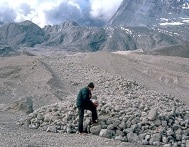A pyroclast is a solid piece of volcanic material that, from the eruption of a volcano , reaches the atmosphere and then falls on the surface. Pyroclasts can present different morphological characteristics.
 At the beginning of an eruption , the volcano emits a jet of gas known as an eruptive column . This gas, which is at a high temperature, is ejected at high speed and can reach a height of about forty kilometers. This eruptive column contains the pyroclasts.
At the beginning of an eruption , the volcano emits a jet of gas known as an eruptive column . This gas, which is at a high temperature, is ejected at high speed and can reach a height of about forty kilometers. This eruptive column contains the pyroclasts.
The higher the eruptive column reaches, the greater the distance the pyroclasts will be dispersed. Generally, the solidification of expelled volcanic material occurs in the air . Pyroclasts can be divided into ashes , lapilli , bombs and slags , according to their morphology.
Some interesting data about these types of pyroclasts are the following:
-Ashes can be microscopic and normally have a diameter that is less than 2 millimeters. It should also be noted that it is transported by the wind over a long distance.
-The lapilli, for its part, we can establish that it has a size that ranges between 2 and 64 millimeters. It is lava that is fragmented and solidifies when it is thrown into the air and comes into contact with it.
-Volcanic bombs are those that have a rounded appearance, as a general rule, and exceed 64 millimeters in size. It must be established that they have a plastic consistency and that, when thrown into the air, they solidify.
-The slag, which also responds to the name of tephra. It is identified by being pieces of porous lava that are produced as a result of the rapid release of gases that takes place. It can be several centimeters in size, making it one of the largest pyroclasts.
It is important to keep in mind that, inside the planet, there is magma : an igneous mass that is melting. Magma solidifies as it cools, which occurs after eruption. In the case of pyroclasts, they are solidified and fragmented magma that rises with the eruptive column and is distributed by the wind.
The fall of pyroclasts carries various risks . It can cause everything from fires to burials, including the development of layers of suspended particles that remain in the air.
It should be noted that the aggregation of pyroclasts allows the formation of so-called pyroclastic rocks . Among them it is possible to recognize varieties such as ignimbrites and volcanic tuffs . All pyroclastic rocks are igneous rocks (they are formed by the solidification of magma) and volcanic rocks (said solidification occurs at shallow depths or on the surface ).
In Spain there is a place where you can closely observe a large number of pyroclasts. We are referring, specifically, to the Canary Islands. There, both in Tenerife and Lanzarote, there is a huge variety of them.
